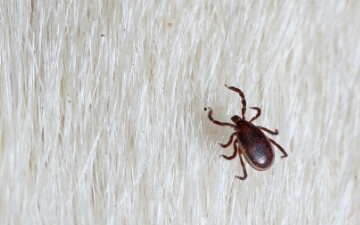
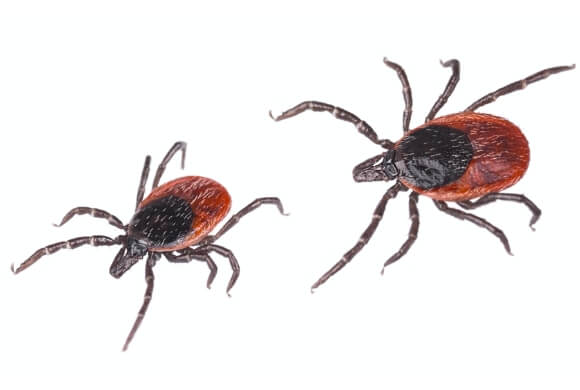
1. Another Common Name for Black-Legged Tick Is Deer Tick
You may know eastern and western black-legged ticks by their more common name: deer ticks. Black-legged ticks feed in copious numbers on white-tailed deer. However, they can be found on many other types of animals. Black-legged ticks tend to inhabit forested areas with an abundance of leaf litter, brush, and grasses, and they can also be found in similar areas around your home.
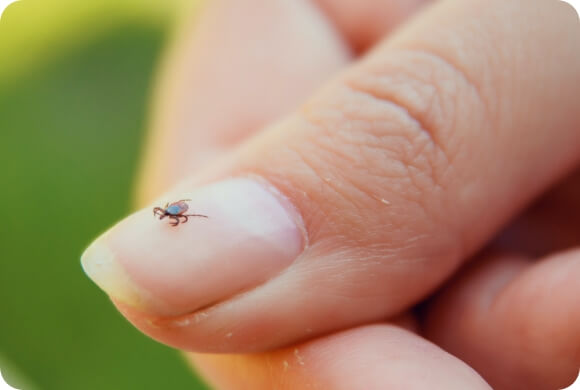
2. Black-Legged Ticks Are Small
Black-legged ticks can be hard to spot. Adult female black-legged ticks have 8 legs and appear two-toned with a dark “shield” covering the front third of the body, with the remainder being an orange-brown color. Their coloration makes it easy for them to blend into the woody habitat. Females are slightly larger than males, but in general an adult black-legged tick is one-eighth of an inch across, while a nymph (a juvenile tick) is just the size of a pinhead. The tiny size of black-legged ticks makes them easy to miss. In fact, they’re so small that it can be difficult to recognize a black-legged tick bite until the tick is engorged.
Black-legged ticks can take about 2-3 years to complete their life cycle. After hatching, they spend roughly the first year of its life as larvae. In the second year of life, they become nymphs before they molt to the adult stage. Even though they drink blood, black-legged ticks spend most of their time in the environment and not attached to a host. In fact, most black-legged ticks will only have 3 blood meals in their entire lives.1
Female black-legged ticks typically lay their eggs in mid-May. The eggs hatch and larvae emerge in the late summer. At this stage, the tick larvae feed on smaller animals such as rodents or birds. By springtime, the larvae develop into nymphs and start attaching themselves to larger hosts such as cats, birds, opossums, raccoons, rodents, deer, and humans. After taking their first blood meal, the nymphs will mature into adult ticks. Adults can be found year-round but are most active from October-May. Female adult ticks will lay masses of eggs, typically in broods of 1500 to 2000, starting the process all over again.2

4. Black-Legged Ticks Can Transmit Lyme Disease
Black-legged ticks are well-known carriers of Lyme disease. On average, 1 in 3 adult black-legged ticks carry Lyme disease, while 1 in 5 nymphs carry it.1 An infected tick must stay attached to its host for at least 24 hours to transmit Lyme disease. Black-legged ticks are so small that it’s easy to miss a tick bite, especially if the tick is attached to a dog with dark skin or a thick haircoat. Lyme disease may even affect a tick’s life cycle and behavior: a recently published study showed that ticks that carry Lyme disease not only live longer but also are more active in the winter than their unaffected peers.3
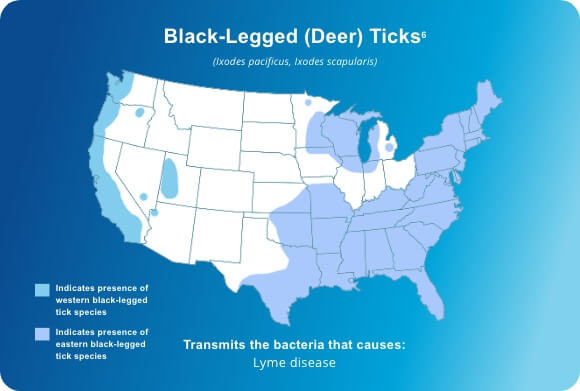
5. Black-Legged Ticks Are Found Across the Country
Black-legged ticks are usually thought only to live in the northeastern United States, especially the northeastern woodlands, but their habitat is larger than that. Black-legged ticks live throughout the central and eastern United States, wherever you find deer and rodents. There are also populations of western black-legged ticks (Ixodes pacificus) found west of the Rocky Mountains. Western black-legged ticks also carry Lyme disease. That means that ticks carrying Lyme disease are widely distributed across the country. A study published in 2016 found that black-legged ticks live in half of all counties in the United States.4
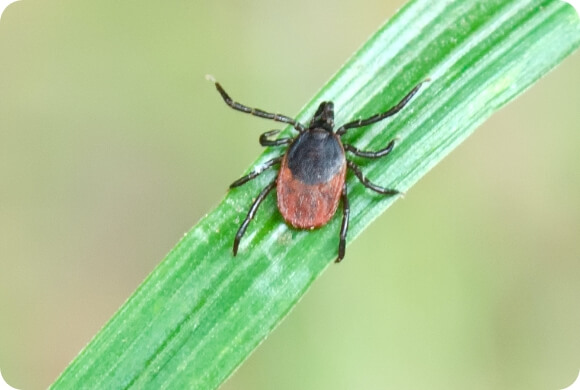
6. Black-Legged Ticks Don’t Jump or Fly
You may be wondering how black-legged ticks attach to their hosts. The answer is surprisingly simple: blacklegged ticks don’t have wings, and they’re not jumpers like fleas or other parasites. Instead, they crawl to the tips of grass or low-lying shrubbery and wait for passing hosts such as deer, dogs, cats, and even humans. Once they sense an animal close by, they snag the new host as it passes by and begin exploring the body of their hosts in order to attach and feed. The greatest risk of exposure to black-legged ticks tends to be in the fringe areas of forests, such as trails, tall grasses, and low-lying shrubbery.
References
- 1. Ticks. Minnesota Department of Health. Accessed Aug 18, 2022. https://www.health.state.mn.us/diseases/tickborne/ticks.html
- 2. Blacklegged (Deer) Tick. Tick Encounter: The University of Rhode Island. Accessed Aug 18, 2022. https://web.uri.edu/tickencounter/species/blacklegged-tick
- 3. Pennisi, E. Lyme-carrying ticks live longer—and could spread farther—thanks to warmer winters. Science. Accessed Aug 18, 2022. https:// www.science.org/content/article/lyme-carrying-ticks-live-longer-and-could-spread-farther-thanks-warmer-winters#:~:text=borrelia%20makes%20ticks%20more%20active,spread%20disease%2C%E2%80%9D%20Ferguson%20says
- 4. Asher, C. Lyme disease–carrying ticks are now in half of all U.S. counties. Science. Accessed Aug 18, 2022. https://www.science.org/content/article/lyme-disease-carrying-ticks-are-now-half-all-us-counties
- 5. Tick Geographic Distribution. Center for Disease Control. http://www.cdc.gov/ticks/geographic_distribution.html. Accessed October 16, 2020.

